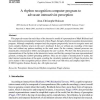90 search results - page 3 / 18 » Grasp Recognition for Programming by Demonstration |
CHI
2009
ACM
14 years 8 months ago
2009
ACM
The Graspables project is an exploration of how measuring the way people hold and manipulate objects can be used as a user interface. As computational ability continues to be impl...
ECCV
1994
Springer
14 years 9 months ago
1994
Springer
In previous applications, bilateral symmetry of objects was used either as a descriptive feature in domains such as recognition and grasping, or as a way to reduce the complexity o...
ICOST
2007
Springer
14 years 1 months ago
2007
Springer
This paper defines a new, context-driven programming model for pervasive spaces. Existing models are prone to conflict, as it is hard to predict the outcome of interleaved actions ...
BSN
2006
IEEE
14 years 1 months ago
2006
IEEE
We demonstrate that simple, unobtrusive sensors attached to the lower arm can be used to capture muscle activations during specific hand and arm activities such as grasping. Spec...
COGSCI
2004
13 years 7 months ago
2004
This paper advocates the main ideas of the interactive model of representation of Mark Bickhard and the assimilation/accommodation framework of Jean Piaget, through a rhythm recog...

